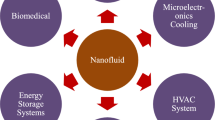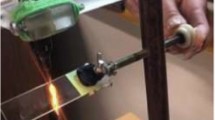Abstract
In this study, a cryogenic abrasive air jet machining (CAAJM) experimental system is designed and built based on the glass transition characteristics of polydimethylsiloxane (PDMS). Fixed processing parameters are then used to evaluate the effectiveness of machining PDMS by abrasive air jet machining (AAJM) at room and cryogenic temperatures, and the results show that cryogenic could improves the processing quality of PDMS. Furthermore, the potential effects of cryogenic treatment on the mechanical properties and wettability of PDMS were analyzed. The results showed that the mechanical properties was slightly decreased under cryogenic treatment, but the wettability was slightly increased. These resulted will further promote the application of CAAJM in the field of microfluidic analytical system. Based on this, experiments are conducted into how microchannel processing quality is influenced by the scanning speed and the erosion distance, pressure, and angle. The results show that better PDMS microchannels are processed when the erosion distance is 2.5–3.5 μm, the erosion pressure is 0.4 MPa, the erosion angle is 60–75°, and the scanning speed is 0.25 mm/s.













Similar content being viewed by others
Data availability
The datasets generated during and/or analyzed during the current study are available from the corresponding author on reasonable request.
References
Melentiev R, Fang FZ (2019) Recent advances and challenges of abrasive jet machining. CIRP J Manuf Sci Tec 22:1–20. https://doi.org/10.1016/j.cirpj.2018.06.001
Aurich JC, Kirsch B, Setti D, Axinte D, Beaucamp A, Butler-Smith P, Yamaguchi H (2019) Abrasive processes for micro parts and structures. CIRP Ann-Manuf Techn 68(2):653–676. https://doi.org/10.1016/j.cirp.2019.05.006
Shi LP, Fang Y, Dai QW, Huang W, Wang XL (2018) Surface texturing on SiC by multiphase jet machining with microdiamond abrasives. Mater Manuf Process 33(13):1415–1421. https://doi.org/10.1080/10426914.2017.1401723
Hwang J, Cho YH, Park MS, Kim BH (2019) Microchannel Fabrication on Glass Materials for Microfluidic Devices. Int J Precis Eng Manuf 20(3):479–495. https://doi.org/10.1007/s12541-019-00103-2
Nouhi A, Spelt JK, Papini M (2018) Abrasive jet turning of glass and PMMA rods and the micro-machining of helical channels. Precis Eng 53:151–162. https://doi.org/10.1016/j.precisioneng.2018.03.010
Arab J, Dixit P, Brahmankar PK, Pawade RS, Srivastava AK (2020) Micro-Faraday cup array structures fabrication in silicon using deep reactive ion etching. Int J Precis Techn 9(1):37. https://doi.org/10.1504/IJPTECH.2020.109760
Prakash S, Kumar S (2015) Fabrication of microchannels on transparent PMMA using CO2 Laser (10.6 μm) for microfluidic applications: An experimental investigation. Int J Precis Eng Manuf 16:361–366. https://doi.org/10.1007/s12541-015-0047-8
Hsieh SS, Kuo JK, Hwang CF, Tsai HH (2004) A novel design and microfabrication for a micro PEMFC. Microsyst Technol 10(2):121–126. https://doi.org/10.1007/s00542-003-0321-z
Padilla S, Tufekcioglu E, Guldiken R (2018) Simulation and verification of polydimethylsiloxane (PDMS) channels on acoustic microfluidic devices. Microsyst Technol 24:3503–3512. https://doi.org/10.1007/s00542-018-3760-2
Getu H, Spelt JK, Papini M (2008) Cryogenically assisted abrasive jet micromachining of polymers. J Micromech Microeng 18(11):115010. https://doi.org/10.1088/0960-1317/18/11/115010
Axinte D, Guo YB, Liao ZR, Albert JS, Saoubie RM, Sugitaf N (2019) Machining of biocompatible materials-Recent advances. CIRP Ann-Manuf Techn 68(2):629–652. https://doi.org/10.1016/j.cirp.2019.05.003
Thakur A, Manna A, Samir S (2019) Performance evaluation of different environmental conditions on output characteristics during turning of EN-24 Steel. Int J Precis Eng Manuf 20(10):1839–1849. https://doi.org/10.1007/s12541-019-00179-w
Natarajan Y, Murugasen PK, Sundarajan LR, Arunachalam R (2019) Experimental investigation on cryogenic assisted abrasive water jet machining of aluminium alloy. Int J Pr Eng Man-Gt 6(3):415–432. https://doi.org/10.1007/s40684-019-00072-x
Matthias P, Martin D, Mike N, Torsten S (2016) Mechanism of Cutting Elastomers with Cryogenic Cooling. CIRP Ann-Manuf Techn 65(1):73–76. https://doi.org/10.1016/j.cirp.2016.04.075
Song K, Gang GM, Jun MBG, Min BK (2017) Cryogenic machining of PDMS fluidic channel using shrinkage compensation and surface roughness control. Int J Precis Eng Manuf 18(12):1711–1717. https://doi.org/10.1007/s12541-017-0199-9
Gradeen AG, Spelt JK, Papini M (2012) Cryogenic abrasive jet machining of polydimethylsiloxane at different temperatures. Wear 274–275:335–344. https://doi.org/10.1016/j.wear.2011.09.013
Gradeen AG, Papini M, Spelt JK (2014) The effect of temperature on the cryogenic abrasive jet micro-machining of polytetrafluoroethylene, high carbon steel and polydimethylsiloxane. Wear 317(1–2):170–178. https://doi.org/10.1016/j.wear.2014.06.002
Li HZ, Wang J, Kwok N, Nguyen T, Yeoh GH (2018) A study of the micro-hole geometry evolution on glass by abrasive air-jet micromachining. Mater Manuf Process 31:156–161. https://doi.org/10.1016/j.jmapro.2017.11.013
Valverde GB, Jimbo R, Teixeira HS, Bonfante EA, Janal MN, Coelho PG (2013) Evaluation of surface roughness as a function of multiple blasting processing variables. Clin Oral Implan Res 24:238–242. https://doi.org/10.1111/j.1600-0501.2011.02392.x
Jafar RHM, Spelt JK, Papini M (2013) Surface roughness and erosion rate of abrasive jet micro-machined channels: Experiments and analytical model. Wear 303(1–2):138–145. https://doi.org/10.1016/j.wear.2013.03.005
Jia J, Song Q, Liu Z, Wang B (2019) Effect of wall roughness on performance of microchannel applied in microfluidic device. Microsyst Technol 25(6):2385–2397. https://doi.org/10.1007/s00542-018-4124-7
Ghobeity A, Crabtree HJ, Papini M, Spelt JK (2012) Characterisation and comparison of microfluidic chips formed using abrasive jet micromachining and wet etching. J Micromech Microeng 22(2):025014–025023. https://doi.org/10.1088/0960-1317/22/2/025014
Park DS, Cho MW, Lee H, Cho WS (2004) Micro-grooving of glass using micro-abrasive jet machining. J Mater Process Tech 146(2):234–240. https://doi.org/10.1016/j.jmatprotec.2003.11.013
Schlautmann S, Wensink H, Schasfoort R, Elwenspoek M, Berg A (2001) Powder-blasting technology as an alternative tool for microfabrication of capillary electrophoresis chips with integrated conductivity sensor. J Micromech Microeng 11(4):386–389. https://doi.org/10.1088/0960-1317/11/4/318
Sayah A, Thivolle PA, Parashar VK, Gijs MAM (2009) Fabrication of microfluidic mixers with varying topography in glass using the powder-blasting process. J Micromech Microeng 19(8):85024. https://doi.org/10.1088/0960-1317/19/8/085024
Solignac D, Sayah A, Constantin S, Freitag R, Gijs MAM (2001) Powder blasting for the realization of microchips for bio-analytic applications. Sensor Actuat A- Phys 92(1–3):388–393. https://doi.org/10.1016/S0924-4247(01)00577-5
Hupert ML, Jackson JM, Wang H, Witek MA, Kamande J, Milowsky MI, Whang YE, Soper SA (2014) Arrays of high-aspect ratio microchannels for high-throughput isolation of circulating tumor cells (CTCs). Microsyst Technol 20(10–11):1815–1825. https://doi.org/10.1007/s00542-013-1941-6
Senthilkumar D (2014) Thermophysical behavior of cryogenically treated silicon carbide for nanofluids. Mater and Manuf Process 29(7):819–825. https://doi.org/10.1080/10426914.2014.892976
Brecker JN (1974) The fracture strength of abrasive grains. Journal of Engineering for Industry 96(4):1253–1257. https://doi.org/10.1115/1.3438503
Michael PC, Aized D, Rabinowicz E, Iwasa Y (1990) Mechanical properties and static friction behaviour of epoxy mixes at room temperature and at 77 K. Cryogenics 30(9):775–786. https://doi.org/10.1016/0011-2275(90)90275-H
Yasuhiro K, Nobuhito Y, Tojiro A (2008) Micromachining of Soft Polymer Material applying Cryogenic Cooling. J Adv Mech Des Syst Manuf 4(2):560–569. https://doi.org/10.1299/jamdsm.2.560
Zhang GG, Sun YL, Gao H, Liu X, Zuo DW (2021) PDMS material embrittlement and its effect on machinability characteristics. J Manuf Process 67:116–127. https://doi.org/10.1016/j.jmapro.2021.04.057
Chiang D, Tsai ML, Lee S (2013) The tensile force oscillation of polycarbonate at elevated temperatures. Polym Eng Sci 53(3):589–596. https://doi.org/10.1002/pen.23286
Zhang SW (1989) Advances in studies on rubber abrasion. Tribol Int 22(2):143–148. https://doi.org/10.1016/0301-679X(89)90175-8
Zhang GG, Sun YL, Qian BK, Gao H, Zuo DW (2020) Experimental study on mechanical performance of polydimethylsiloxane (PDMS) at various temperatures. Polym Test 90:106670. https://doi.org/10.1016/j.polymertesting.2020.106670
Seghir R, Arscott S (2015) Extended PDMS stiffness range for flexible systems. Sens Actuators, A 230:33–39. https://doi.org/10.1016/j.sna.2015.04.011
Melentiev R, Fang F (2019) Theoretical study on particle velocity in micro-abrasive jet machining. Powder Technol 344:121–132. https://doi.org/10.1016/j.powtec.2018.12.003
Wang YF, Yang ZG (2008) Finite element model of erosive wear on ductile and brittle materials. Wear 265(5–6):871–878. https://doi.org/10.1016/j.wear.2008.01.014
Funding
This work has been supported by the National Natural Science Foundation of China (Grant No. 52075254), Project supported by the Joint Funds of the National Natural Science Foundation of China (No. U20A20293) and Postgraduate Research & Practice Innovation Program of Jiangsu Province (KYCX20_0183).
Author information
Authors and Affiliations
Contributions
GZ: Investigation, Data curation, Visualization, Writing—original draft. YS: Project administration, Funding acquisition, Writing—review & editing. XL: Investigation, Visualization. HG: Data curation, DZ: Conceptualization, Supervision. Visualization.
Corresponding author
Ethics declarations
Conflict of interest
On behalf of all authors, the corresponding author states that there is no conflict of interest.
Ethical approval
Not applicable.
Consent to participate
Not applicable.
Consent to publish
Not applicable.
Additional information
Publisher's note
Springer Nature remains neutral with regard to jurisdictional claims in published maps and institutional affiliations.
Rights and permissions
About this article
Cite this article
Zhang, G., Sun, Y., Liu, X. et al. Experimental investigations of machining characteristics on polydimethylsiloxane (PDMS) by cryogenic abrasive air-jet machining. Int J Adv Manuf Technol 118, 2711–2723 (2022). https://doi.org/10.1007/s00170-021-08147-3
Received:
Accepted:
Published:
Issue Date:
DOI: https://doi.org/10.1007/s00170-021-08147-3




